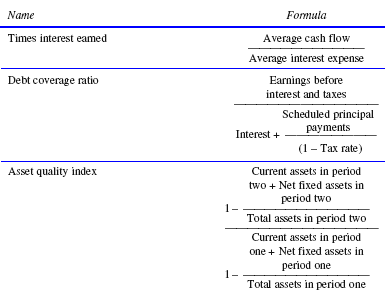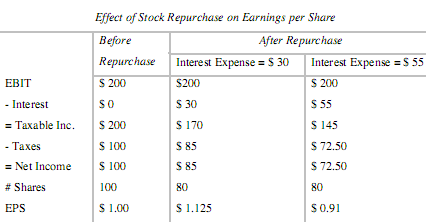About 'accounting debt to equity ratio'|A Credible Solution to Europe’s Debt Crisis: A “Trichet Plan” for the Eurozone
You face two problems with fundamental analysis. First, abuses of the past show that you cannot rely on financial statements, even with the "independent" audit. Second, GAAP (Generally Accepted Accounting Principles) rules allow great latitude for companies in how they report. The solution is to use three fundamentals that cannot be hidden or manipulated. All depend on analysis of a trend over several years and not on one-year ratios. These are: 1. Dividend growth. Seek companies that have increased their dividend every year for at least ten years ("dividend achievers"). A company must have funds available to pay dividends, so this is a great sign of sound management. Stocks of these companies also tend to be less volatile than average, and to grow over time. 2. Many years of growth in revenues and net profits. Check long-term growth in revenue dollars along with net return. If net return slips while revenues rise, is indicates diminishing control. As long as net return remains at the same percentage over five to 10 years, management is doing its job. It is impossible to manipulate these outcomes for more than a year or two. 3. A two-part test of working capital. You might believe that the current ratio is all you need to test working capital. This traditional test (comparing current assets to current liabilities) is valuable, but it is only part of the story. Check the debt ratio too. This is the percentage of long-term debt to total capitalization ("total" means equity plus long-term debt). The percentage should be holding steady or declining. Whenever you see the debt ratio increasing over the years, that is a danger signal - even if current ratio stays the same. It could mean that management is using part of long-term debt to keep in cash just to keep the current ratio looking healthy. To show why you need all three tests, consider the case of Sears Holding (SHLD). In each of the last four years going back to 2009, revenues and net income were inconsistent: In Millions of dollars Year Revenue Net Income net return 2012 $41,567 $ -3,113 - 7.5% 2011 43,326 150 0.3 2010 44,043 235 0.5 2009 46,770 53 0.1 Revenues fell erratically each year and net return provided no reliable trend. Even with these net losses, the current ratio remained between 1 and 2 for every year going back four years. How is that possible? Compare current ratio to debt ratio for four years: Current Debt Year Ratio Ratio 2012 1.1 27.3% 2011 1.3 22.6 2010 1,3 14.6 2009 1.3 10.8 By itself, current ratio looks great. When you also review debt ratio and see it moving upward from 10.8% to 27.3% over four years, the overall test is negative. This example demonstrates how to evaluate the fundamentals. A test of the long-term trend reveals the true strength or weakness of the company. To gain more perspective on insights to trading observations and specific strategies, I hope you will join me at ThomsettOptions.com where I publish many additional articles. I also enter a regular series of daily trades and updates. For new trades, I usually include a stock chart marked up with reversal and confirmation, and provide detailed explanations of my rationale. Link to the site at ThomsettOptions.com to learn more. I also offer a weekly newsletter subscription if you are interested in a periodic update of news and information and a summary of performance in the virtual portfolio that I manage. All it requires is your e-mail address. Join at Weekly Newsletter I look forward to having you as a subscriber. |
Image of accounting debt to equity ratio
accounting debt to equity ratio Image 1
accounting debt to equity ratio Image 2
accounting debt to equity ratio Image 3
accounting debt to equity ratio Image 4
accounting debt to equity ratio Image 5
Related blog with accounting debt to equity ratio
- stocknewsportal.blogspot.com/... equity carried on the...of stock, you will want to know the book value per...to get the �current ratio.� A current ratio of...not have any long term debt, or at least none ...
- coobulldog.wordpress.com/...of the DuPont Analysis. To explain the power of leverage...company, that is, the ratio of Capital, Debt and Equity. Let’s start out by...no difference between the account of capital (debt + equity...
- jeremyowinvestingexperience.blogspot.com/...of such debt ratios, we need to first look at...operational and debt ...type include accounts payable, .... Debt-Equity Ratio Debt-equity...
- waelsasso.wordpress.com/...for Inventory and Account Payables.... Most ratios with the term...ratios that seem to have a name ...X 1 Return on Equity NI / Average Equity...X 2 Long Term Debt to Equity Long Term...
- ivythesis.typepad.com/.... Equity method of accounting has ... in capacity to gauge ...like EPS or P/ E ratios. Unless full consolidation...
- deweynortonmba.wordpress.com/...negotiate with a bishop. At the end of this, the United States will have a debt to equity ratio at about the same level as Italy. Not surprising as the level of incompetence and...
- www.ritholtz.com/blog/...In a hypothetical example, if a “Trichet Plan” country with an initial 140 percent debt to GDP ratio can grow by 5 percent per annum (in nominal terms) over a seven years...
- financecosmos.wordpress.com/...on the Profit and loss account) to the value of fixed...the higher the ratio, the better, because...SOLVENCY RATIOS 1. Debt to equity ratio Debt to equity ratio...
- marginofsafteyinvesting.wordpress.com/...potentially be attractive. To do that I look at 2 ratios: Cash returns...enterprise value (value of equity + debt – cash). In a sense... not take into account debt or cash and can...
- ramyajyothsna.wordpress.com/...And educative thesis about depreciation, appreciation, debt-equity ratios and stuff like that! But accounts still seems illogical to me! P.S: it’s just my comprehension...
Accounting Debt To Equity Ratio - Blog Homepage Results
optimalby
...Tree Global High Yielding Equity Index Oppenheimer Global Russell Global...for Minors Acid Test Ratio Active Participant Accumulated...Coverdell Education Savings Account Cross Purchase Crummey Power Cummulative...
Related Video with accounting debt to equity ratio
accounting debt to equity ratio Video 1
accounting debt to equity ratio Video 2
accounting debt to equity ratio Video 3






0 개의 댓글:
댓글 쓰기